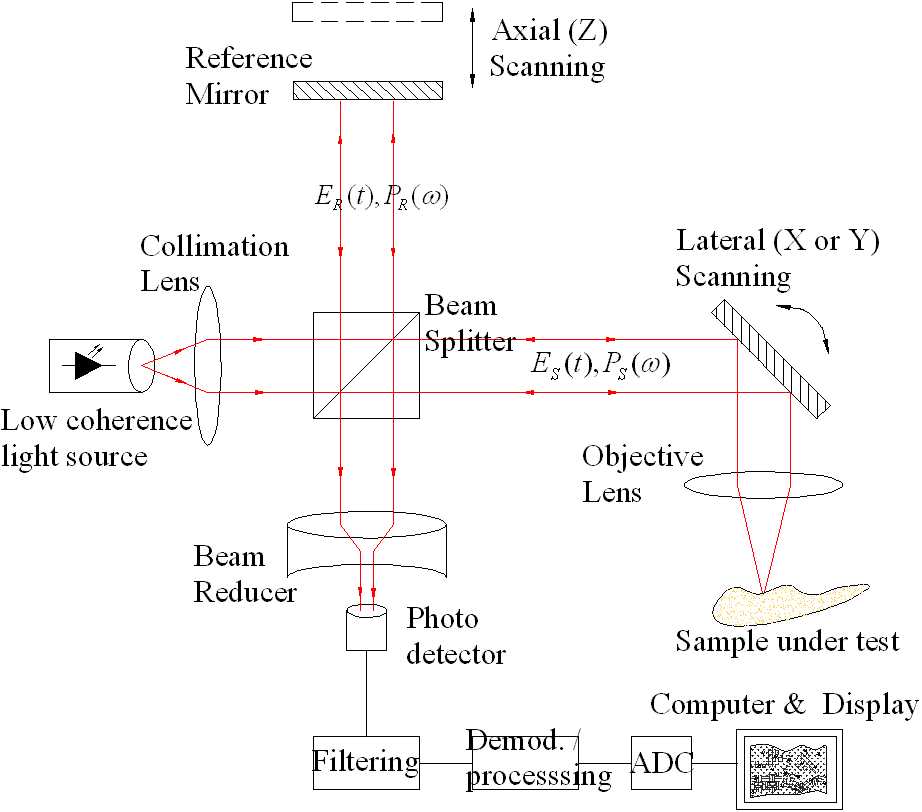In the following, I would like to outline how transparent polygon scanning can be used to save lives. I again aim to create prior art to extend the freedom of use of transparent polygon scanning.
Typical optical setup of single point OCT. Scanning the light beam on the sample enables non-invasive cross-sectional imaging up to 3 mm in depth with micrometer resolution

Optical Coherence Tomography (OCT) is an imaging technique that uses low-coherence light to measure samples based upon the principle of light interference. It is used in the medical industry to detect cancer in tissues and diseases in eyes, e.g. the Cylite of Hewlett Packard. OCT is typically used to obtain information from a sample. In 3D printing it has been used to verify a print. For example, Photoncontrol used Optical Coherence Tomography and Raman spectroscopy to test the quality of bio-printed tissue, see 1. A startup, called Inkbit from MIT, is using it to create samples accurately. They print droplets with an inkjet head and then verify the position of these droplets using among others OCT.
OCT has also been used to detect the adhesion between layers in a 3D printing process, see Non-destructive testing of layer-to-layer fusion of a 3D print using ultrahigh resolution optical coherence tomography.
Due to the interest in this area, I decided to elaborate upon how OCT can be used in combination with a transparent polygon scanner. I claim that in figure 2 a transparent polygon scanner is used instead of a galvo scanner. I claim that in the optical path of the Hexastorm a beam splitter is placed after the aspherical lens and before the first cylindrical lens to enable the scanner for optical coherence tomography. I claim the use of a transparent polygon scanner for wavefront measurement in Ophthalmology and Optometry. The vertical measure of an eye ball, generally less than the horizontal, is about 24 mm. The current scan head has a scanline of maximum 24 mm, making it already close to dimensions required for eye ball measurement. I claim that possibly two transparent polygon scanners are used in ophthalmology and optometry, to move the bundle in two directions.
An OCT enabled transparent polygon scanner might also be useful for 3D printing. Imagine that a small percentage of the bundle is scattered to the reference mirror and most of it used to go to the sample. It will then be possible to sinter powders or polymerize liquids at the sample location. A small portion of the beam will be reflected and refract back to the beam splitter and interfere with the reference beam at the photo-detector.
This allows one to measure the photo-polymerization or sintering process during printing. I can imagine this is especially useful if the layer height is less than the wavelength. I can also imagine that this is useful during a process akin to Hexaforming (see previous post). A hand held device could be used to check the skin of a patient. An application would be laser surgery, such as eye surgery (Carl Zeiss Meditech) or tattoo removal and laser hair removal.
The transparent polygon scanner could also be useful in a Raman microscope as galvo's are used by NanoPhoton. In two-photon point-scanning microscopy,temporal focussing can be used to increase the image rate for a transparent polygon scanner similar to a galvo setup. Another option is in vivo imaging with HiLo microscropy but then a transparent polygon scanner. Further possibility is Field-portable quantitive lenssless microscopy based on translated speckle illumation on sub-sampled ptychographic phase retrieve using a transparent polygon scanner. Or A New Method of Creating High-Temperature Speckle Patterns and Its Application in the Determination of the High-Temperature Mechanical Properties of Metals with a transparent polygon scanner.
Another option is laser scanning fluorence microscopy with a transparent polygon scanner instead of a scanning mirror. The dichroic mirror could be positioned between the first cylinder lens and the aspherical lens. If a pinhole is added before the camera, we have just created a transparent polygon scanning confocal microscope, see video.
Another option is edge radius measurement, with a transparent polygon scanner.
 Hexastorm
Hexastorm
Discussions
Become a Hackaday.io Member
Create an account to leave a comment. Already have an account? Log In.